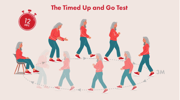Could more people benefit from home adaptation support for hidden disabilities?
Millions of people in the UK live with hidden disabilities - conditions that aren’t always visible but can have a profound impact on everyday life. For some, making the home safer, more comfortable, and easier to navigate can be life changing.
While many have heard of the Disabled Facilities Grant (DFG), the details of who can access it, what it can cover, and the recent increases in funding aren’t always widely known, particularly among those with less visible conditions such as long COVID, Parkinson’s, fibromyalgia, chronic fatigue syndrome, and other autoimmune disorders.
Hidden disabilities - not always visible, always valid
A hidden (or invisible) disability is any physical, mental, or neurological condition that isn’t immediately apparent to others. Examples include:
- Long COVID
- Chronic fatigue syndrome (CFS/ME)
- Rheumatoid arthritis
- Parkinson’s disease
- Chronic pain
- Hearing loss
- Certain mental health conditions
These conditions can limit mobility, reduce energy, or make daily tasks more challenging, even if the effects can’t be seen at a glance.
The DFG - more than just a funding pot
The DFG is a long-standing source of support for people who need to adapt their homes due to disability. Available across the UK, it can provide up to:
- £30,000 in England
- £36,000 in Wales
- £25,000 in Northern Ireland
- In Scotland, similar support is available through local councils
The grant can help fund adaptations such as stairlifts or home lifts, wet rooms, widened doorways, ramps, or accessible kitchen and bathroom layouts. For smaller changes under £1,000, local councils may fund them directly without a full DFG application.
How it fits with other support
The DFG is separate from Personal Independence Payment (PIP). While PIP supports everyday living costs, the DFG focuses specifically on home adaptations. Receiving one doesn’t automatically mean eligibility for the other, as they are assessed independently.
Why it isn’t reaching everyone who could benefit
Even with awareness of the DFG, practical barriers remain. For those living with fatigue, fluctuating symptoms, or pain, the process - from means testing to an occupational therapist’s assessment - can be challenging.

Inclusive Design expert Amy Francis-Smith, who works with Stannah, explains:
“Just because a disability isn’t visible doesn’t mean it’s less deserving of support. The DFG can be transformative, but more people need to feel empowered to explore it before their needs become urgent.”
Why it matters now
The UK government has pledged an additional £86 million in DFG funding alongside a review of social care. With the cost of living high and demand for accessible housing growing, making sure people know how and when to access support has never been more important.
Taking the next step
If you or someone you know could benefit from home adaptations, your local council’s website is the best place to start. An occupational therapist can offer guidance on what’s possible and how to navigate the process.
Accessible living shouldn’t be something we think about only in moments of crisis - it should be part of planning for a safer, more supportive future at home.
Stay up to date
Latest Blogs

Dame Zandra Rhodes x Stannah: When accessibility meets style
50 years of Stannah Stairlifts – A milestone grounded in purpose

BBC’s Dr Punam Krishan reveals a little-known Parkinson’s symptom to watch for...

Are you at risk of falling? Dr. Punam Krishan’s simple 12-second test could tell you...

Snore Wars: Could sleeping separately be the secret to a better night’s rest?

Proud to carry the Made in Britain mark!

Stannah wins best TV campaign 2025 at the Silver Marketing Awards

Stannah stairlifts named a Which? Recommended Provider for the 3rd consecutive year!
Stairlifts made for you
All our stairlifts whether straight or curved are customised to suit you and your home so call now to arrange a visit to get your FREE personalised quote!